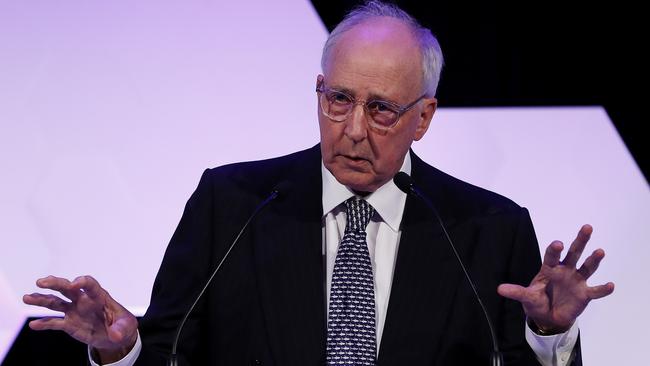
The reality is that dumping or delaying the increase in the superannuation guarantee does not stack up on policy grounds, nor does it stack up politically.
The policy debate about whether the Morrison government should maintain the legislated SG increase cannot be separated from political reality because the risk for the government is that it could undermine its re-election prospects.
Scott Morrison and Josh Frydenberg have not yet decided whether to go ahead with the SG rate increase. The Coalition opposed compulsory superannuation when it was introduced almost 30 years ago and has been uncomfortable with it ever since.
But the Prime Minister and his Treasurer are not ideologues; they are pragmatists. They should know the politics are diabolical.
First, the government would be breaking an election commitment. Morrison went to the election last year asking voters to trust him. His mantra ever since has been that the government will fulfil its promises and meet its commitments. So this would represent a broken promise. It will be an albatross around his neck.
Second, to capitulate on the SG increase would require new legislation to overturn what has already been agreed by the parliament. The SG rate increases to 10 per cent in July next year, then to 10.5 per cent in July 2022, 11 per cent in July 2023, 11.5 per cent in July 2024 and 12 per cent in July 2025. This means any backflip is at the mercy of the Senate crossbench.
Third, the union movement will be roused to battle. There are few issues more totemic for unions than protecting and defending superannuation. It is a product of the political and industrial wings of the labour movement. The ACTU — as I have argued before — has the most sophisticated, well-resourced and competitive campaign machine outside the major political parties.
Although union membership continues to plummet, there are still about 1.5 million members. Individual unions have direct links into workplaces and broader communities. They can marshal an army of paid and non-paid workers. They have money to spend. Imagine a grassroots-style Your Rights at Work campaign, which helped to defeat John Howard’s government in 2007.
Fourth, Australian superannuation funds will oppose any further delay or abandonment of the SG increase. While the Coalition is seeking to limit the advocacy and campaign capacity of funds, every Australian employee is likely to be given data that shows their retirement income significantly reduced in coming decades if the increases do not proceed.
And fifth, the Labor Party will have new life breathed into it with a crusade to protect the retirement incomes of Australian workers. Labor is struggling with a lacklustre leader who fails to inspire. The party is rife with talk of a leadership change as most MPs have all but given up on winning the next election. But a campaign on superannuation shifts the electoral battleground to Labor’s turf.
The combination of unions, super funds and Labor would represent a phalanx of opposition for the Coalition that would be hard to counter. An SG backflip would also energise Paul Keating — the principal architect of superannuation — into the political fray. No Labor figure can generate more attention from voters than Keating. His intervention will further turn up the heat on Morrison and Frydenberg. The Coalition will struggle to win the argument that there is a trade-off between wages and superannuation. It is arguable in theory but voters know the reality is different.
When the SG was frozen at 9.5 per cent in July 2014, wages growth actually slowed. Average wage growth was 3 per cent in the six years before the freeze but 2 per cent in the six years after. The share of national income accruing to labour (wages and super) continues to fall as the share accruing to capital (profits) continues to rise.
Moreover, the Coalition would have to argue the reason they are not increasing retirement incomes is because businesses will instead pay higher wages. This accepts there is a trade-off between super and wages. But the argument that businesses cannot afford to pay an increase in the SG but can afford to pay an increase in wages, and actually will, defies logic.
Australia’s superannuation system has been a huge success. With $2.9 trillion in assets under management, it is the envy of the world. It forces Australians to save to fund their retirement and takes pressure off the Age Pension, and therefore the tax burden on younger generations. As Mike Callaghan’s retirement income review found: “The Australian retirement income system is effective, sound and its costs are broadly sustainable.”
But the system needs reform. Industry fund boards have become a gravy train for retired unionists and Labor MPs. Fees are often excessive and tax concessions too generous. There is a case for a default fund. Early access on hardship grounds or for housing is worthwhile considering. But the danger is it leaves young people with less retirement income and more dependent on the government later in life. And super should not be seen as a panacea for housing affordability.
The Morrison government will make a decision about the SG increase in the lead-up to the budget in May next year. It will want to show the economic recovery from the pandemic continuing to gather pace. By then it will be even harder to argue that boosting the SG to 10 per cent and then 12 per cent is unaffordable, especially when politicians will continue to have their super contribution paid by taxpayers at 15.4 per cent.



It is pure fantasy to expect Australians to willingly give up a legislated increase in their superannuation from 9.5 per cent to 10 per cent of earnings mid next year, and phased to 12 per cent by 2025, in return for the remote chance of an increase in their wages at a time when most incomes have remained stagnant in recent years.